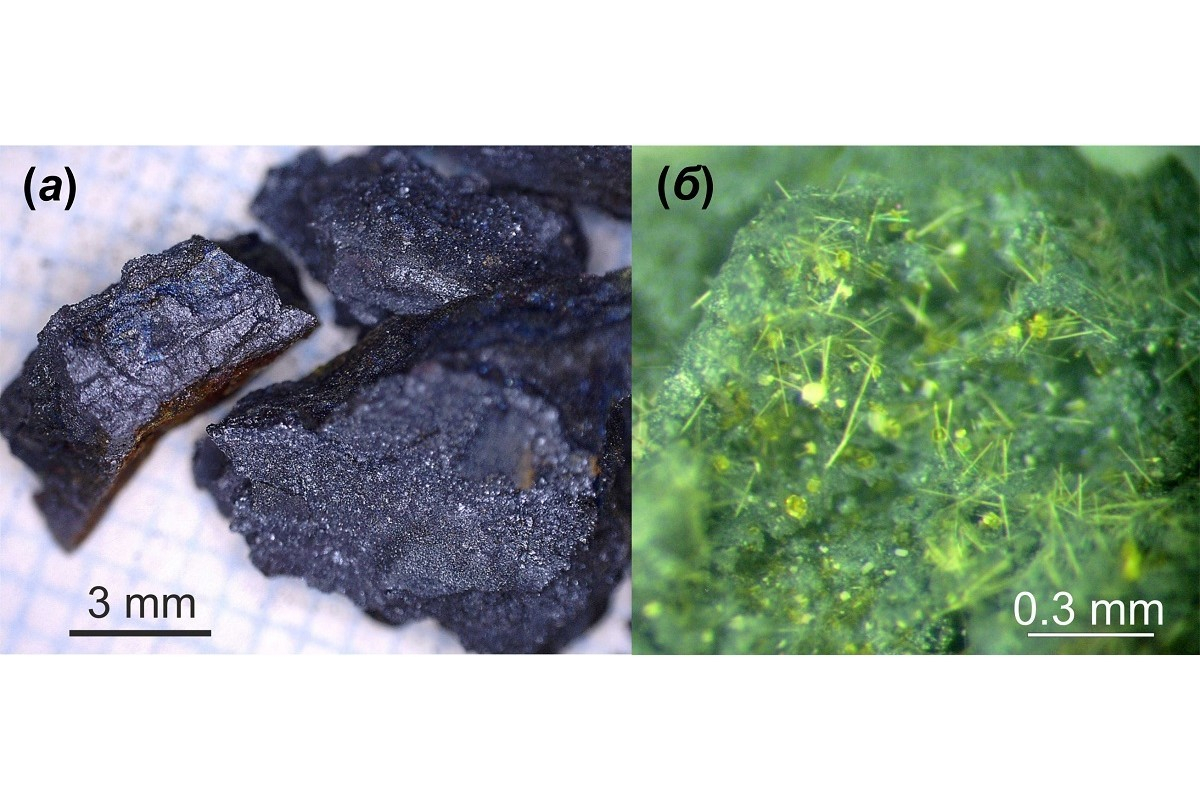St Petersburg University scientist helps find out what happens to highly radioactive Chernobyl material when it interacts with water for a long time
A group of scientists led by Vladislav Gurzhiy, Associate Professor in the Department of Crystallography at St Petersburg University, experimentally studied the evolution of Chernobyl corium in water at elevated temperatures. As a result, two newly formed crystalline uranium-bearing phases were identified. Accurate diagnostics of these phases is important for modelling severe nuclear accidents and their long-term consequences. It is also useful for developing ways to minimise environmental damage and reliably isolate radioactive waste.

Corium is a product resulting from the interaction of nuclear U-oxide fuel and zircaloy cladding, in which this fuel is enclosed. The original highly radioactive sample was manually selected under extreme conditions by employees of the Khlopin Radium Institute Vladimir Zirlin and Larisa Nikolaeva in 1990 in sub-reactor room 305/2 inside the Chernobyl sarcophagus, or the Shelter Structure. Later, the newly formed crystalline uranium-bearing phases were transferred to the authors of the scientific article for laboratory research.
The research findings are published in Materials, an international scientific journal.
The products of nuclear accidents, as well as radioactive waste, often come into contact with water. These can be both atmospheric precipitation and groundwater that affects the materials. According to Vladislav Gurzhiy, head of the research team, Associate Professor in the Department of Crystallography at St Petersburg University, the study of chemical changes in the real Chernobyl corium is significant today. It allows a detailed study of the behaviour of highly radioactive materials interacting with water for a long time.
To speed up the process of changes taking place in the corium, the experiment was carried out with heating. For a year, in the conditions of a radiochemical laboratory at the Radium Institute, the sample was subjected to continuous hydrothermal treatment in distilled water at a temperature of 150 °C. As a result of the study, scientists managed to identify two newly formed crystalline phases on the surface of the corium. These are becquerelite and phurcalite, which are analogues of secondary uranyl minerals found in natural conditions.
St Petersburg University, the oldest university in Russia, was founded on 28 January (8 February) 1724. This is the day when Peter the Great issued a decree establishing the University and the Russian Academy of Sciences. Today, St Petersburg University is an internationally recognised centre for education, research and culture. In 2024, St Petersburg University will celebrate its 300th anniversary.
The plan of events during the celebration of the anniversary of the University was approved at the meeting of the Organising Committee for the celebration of St Petersburg University’s 300th anniversary. The meeting was chaired by Dmitry Chernyshenko, Deputy Prime Minister of the Russian Federation. Among the events are: the naming of a minor planet in honour of St Petersburg University; the issuance of bank cards with a special design; the creation of postage stamps dedicated to the history of the oldest university in Russia; and the branding of the aircraft of the Rossiya Airlines to name just a few. Additionally, the University has launched a website dedicated to the upcoming holiday. The website contains information about outstanding University staff, students, and alumni; scientific achievements; and details of preparations for the anniversary.
Our scientists performed their accurate diagnosis using state-of-the-art equipment from the St Petersburg University Research Park. This made it possible to obtain unique results on microscopic radiation-safe amounts of material, that is, without risk to researchers. According to the crystallographer from St Petersburg University, such studies were previously impossible, since a large amount of hazardous material was required for analysis.
According to Vladislav Gurzhiy the results obtained can be submitted to a computer database for modelling the behaviour of nuclear fuel melting products, which are formed under conditions of severe nuclear accidents and evolve under the influence of the environment.
These data are important both for assessing the stability of the corium under conditions of temporary storage of materials and for their final disposal. For example, if such highly radioactive waste is stored in places with uncontrolled humidity, this will accelerate the process of destruction of the material with the subsequent release of radioactive elements into the environment.
Vladislav Gurzhiy, Associate Professor in the Department of Crystallography at St Petersburg University
’As a result of such man-made disasters, a material unique in its composition and structure is formed, which is almost impossible to reproduce under laboratory conditions. This means that modelling the processes of its formation and subsequent changes without actual material will be very approximate. Even small fragments of corium that formed almost 40 years ago therefore make a significant contribution to understanding how this substance should be handled,’ explained Vladislav Gurzhiy.
As the scientist noted, the material that had been formed at the Fukushima Daiichi Nuclear Power Plant during the 2011 accident, accompanied by the melting of nuclear fuel at three power units, might be chemically different from the Chernobyl sample. Yet the products of its change in water at high temperature would be similar. This is also evidenced by the photos received from the underwater robot in February 2023.
The work was supported by a grant from the Russian Science Foundation (project No 23-17-00080).
In addition, given the unique chemical specificity of the Chernobyl corium, which includes both fragments of nuclear fuel and structural materials, the composition of the new phases obtained as a result of the experiment is somewhat different from their natural analogues. It is very interesting from the perspective of the resistance of these compounds to isomorphic substitutions and in terms of discovering new minerals.
The laboratory studies were carried out at the Centre for X-Ray Diffraction Studies of the St Petersburg University Research Park.

